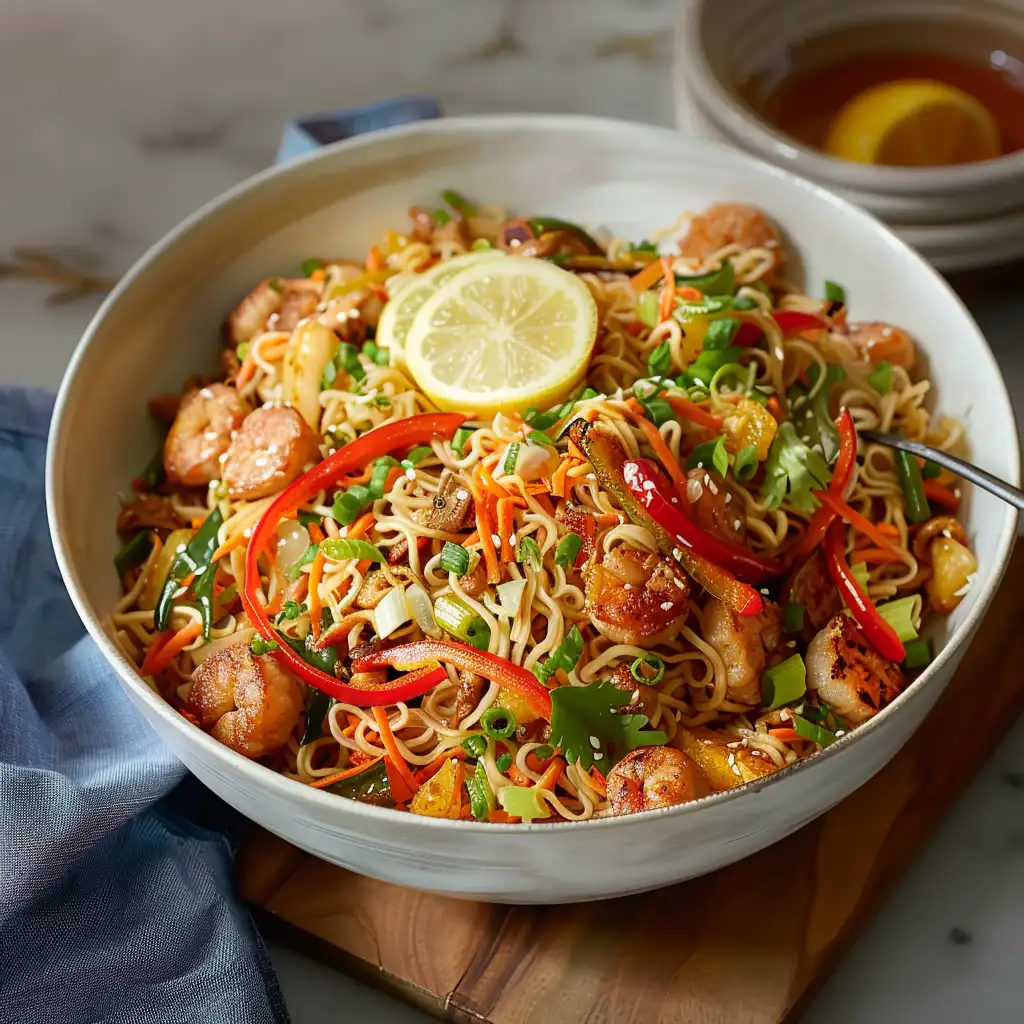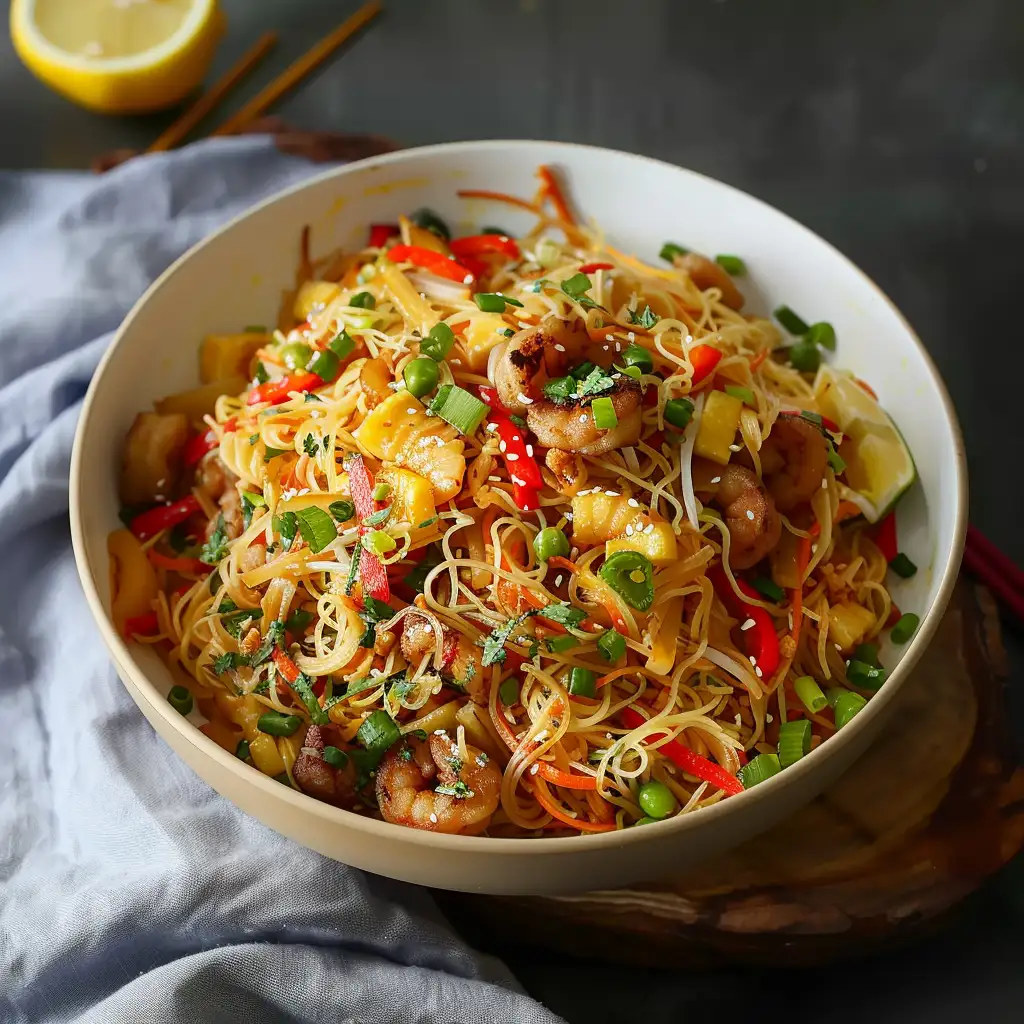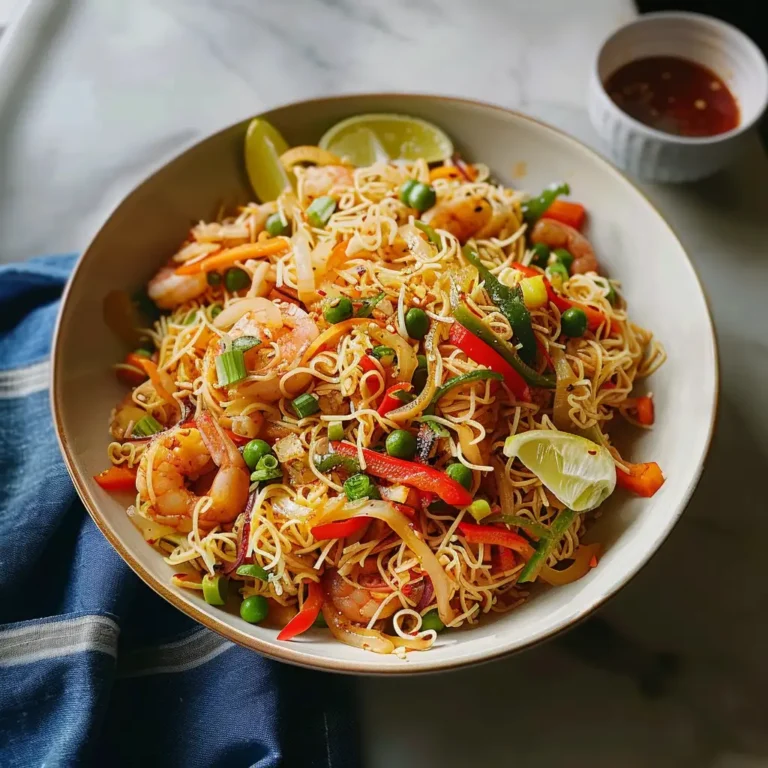Introduction to Pancit
Pancit, a staple in Filipino cuisine, embodies the fusion of indigenous Filipino and Chinese culinary traditions. The word “pancit” is derived from the Hokkien phrase “pian i sit,” which translates to “something conveniently cooked.” Usually, it involves quick-cooking noodles stir-fried with a variety of ingredients. This dish’s origins can be traced back to when Chinese traders introduced noodles to the Philippines, becoming an integral part of Filipino food culture over centuries.
The cultural significance of Pancit in Filipino cuisine cannot be overstated. It is more than just a dish; it is a celebration of life and longevity, often served at birthdays and special occasions to symbolize a wish for a long and prosperous life. Its versatility and ease of preparation have made Pancit a beloved dish across the archipelago, each region adding its unique twist and flavor.
Understanding Pancit
Types of Pancit
Pancit comes in various forms, each with its distinct characteristics. Some of the most popular types include:
- Pancit Canton: Uses wheat noodles, often cooked with soy sauce and a mix of meats and vegetables.
- Pancit Bihon: Features rice vermicelli, sautéed with chicken, pork, shrimp, and vegetables.
- Pancit Palabok: Known for its orange annatto sauce, topped with shrimp, boiled eggs, and crushed chicharron.
Key Ingredients in Pancit
At the heart of any Pancit dish are:
- Noodles: The base of any Pancit, with rice noodles (Bihon) and wheat noodles (Canton) being the most common.
- Vegetables: Commonly used vegetables include cabbage, carrots, and green beans.
- Meats: Chicken, pork, and shrimp are traditional, though tofu can be a substitute for a vegetarian option.
- Seasonings and sauces, particularly soy sauce and sometimes oyster sauce, add depth and flavor to the dish.
Choosing the Right Noodles
The choice of noodles significantly affects the texture and flavor of Pancit. For a traditional Pancit Bihon, thin rice vermicelli is preferred for its light texture. On the other hand, Pancit Canton enthusiasts might opt for thicker, chewier wheat noodles. Understanding the characteristics of each noodle type can elevate the dish, ensuring the noodles complement the mix of seasonings, sauces, and ingredients perfectly.
By incorporating a variety of ingredients and flavors, Pancit serves as a delicious representation of the Philippines’ rich culinary diversity. Its simplicity, coupled with the profound cultural heritage it carries, continues to endear Pancit to hearts and tables worldwide. For more insights into traditional Filipino dishes and their origins, consider exploring Filipino Cuisine History. Additionally, for those interested in making their Pancit healthier, Healthy Cooking Substitutes offers a wealth of information on ingredient substitutions that don’t compromise on flavor.

How to Make Quick and Easy Pancit
Creating a delicious Pancit dish is simpler than you might think. The key to a flavorful Pancit lies in the preparation of ingredients and understanding the cooking process. Whether you’re making Pancit Bihon, Canton, or any other variant, follow these steps for a dish that promises to delight.
Preparing the Ingredients
The foundation of a great Pancit starts with:
- Soaking the noodles: For rice vermicelli (Bihon), soak them in lukewarm water for about 10 minutes or until they’re just soft. Avoid over-soaking, as they will cook further when stir-fried. Wheat noodles for Canton usually don’t require soaking but follow the package instructions to be sure.
- Prepping vegetables and meats: Slice vegetables into thin strips for quick cooking and uniform texture. Common choices include cabbage, carrots, and bell peppers. For meats, thinly slice chicken, pork, or beef, and have shrimp cleaned and ready. The thin slicing ensures that they cook quickly and evenly.
By having all your ingredients prepped and ready to go, you ensure a smooth cooking process, keeping the flavors and textures of your Pancit perfectly balanced.
Cooking Process
Follow these steps for a classic Pancit that’s full of flavor:
- Sautéing onions and garlic: Begin by heating oil in a large pan or wok. Add thinly sliced onions and minced garlic, sautéing until they are translucent and fragrant. This forms the flavorful base for your Pancit.
- Adding meats and vegetables: Add your choice of meat to the pan, cooking until nearly done before incorporating the vegetables. Stir-fry until the vegetables are tender-crisp, ensuring they retain their color and nutrients.
- Mixing in noodles: Drain your pre-soaked noodles and add them to the pan. Pour in a mixture of soy sauce (and oyster sauce if desired) to season. Toss everything together, ensuring the noodles are well-coated with the sauce and ingredients are evenly distributed.
Tips for achieving the perfect texture and flavor:
- Avoid overcooking the noodles to maintain their texture.
- A splash of fish sauce can add depth to the dish.
- Adjust seasonings to taste, balancing soy sauce with a hint of sugar if desired.
For detailed techniques and tips on enhancing your Pancit, consider visiting Cooking Techniques from Professional Chefs.

Serving Suggestions
Pancit is traditionally served as a main dish but can also be a side to other Filipino favorites. To serve:
- Garnishes: Lemon or lime wedges on the side allow guests to add a touch of acidity, brightening the flavors of the Pancit.
- Accompaniments: Serve alongside grilled or roasted meats for a hearty meal. A simple green salad or pickled vegetables can provide a refreshing contrast to the savory noodles.
Remember, the beauty of Pancit lies in its versatility. Feel free to experiment with different vegetables and proteins based on what’s available or suits your dietary preferences. The goal is to create a balanced dish that celebrates the simplicity and richness of Filipino culinary traditions.
Storing and Reheating Pancit
Storing and reheating Pancit properly can make a significant difference in enjoying your delicious leftovers. Following the right methods ensures that your Pancit remains just as appetizing the next day.
Best Practices for Storing Leftovers
- Cool Down: Allow your Pancit to cool to room temperature before storing to prevent condensation inside the container.
- Airtight Containers: Use airtight containers to store Pancit in the refrigerator. This keeps it fresh and prevents it from absorbing other flavors.
- Refrigeration: Properly stored, Pancit can last in the fridge for up to 4 days.
How to Reheat Pancit Without Losing Texture or Flavor
- Stovetop Method: Gently reheat Pancit in a pan over medium heat. Add a splash of water or broth to prevent the noodles from drying out. Stir frequently to ensure even heating.
- Microwave: For a quick option, microwave Pancit covered, with a few tablespoons of water to add moisture. Stir halfway through reheating.
Community Tips and Variations
The versatility of Pancit allows for numerous variations and personalized touches. Here are some insights and popular tweaks:
- Protein Variations: While chicken, pork, and shrimp are traditional, tofu and tempeh offer great vegetarian options without compromising the dish’s essence.
- Vegetable Additions: Seasonal vegetables can add color and nutrition. Consider snow peas, broccoli, or red bell peppers for a vibrant mix.
- Sauce Adjustments: Some cooks like to add a bit of fish sauce for depth or a splash of lemon juice for brightness.
For more inspiration on variations and to explore the diversity of Pancit recipes, visiting sources like Allrecipes can provide a wealth of ideas and community insights.
FAQs
Addressing common questions can help clarify the process of making Pancit and ensure success:
- Can I use different types of noodles? Yes, Pancit is versatile. While rice noodles are most common, feel free to experiment with what you have on hand.
- Is Pancit gluten-free? When made with rice noodles and soy sauce substitutes like tamari, Pancit can be gluten-free.
- How can I make Pancit vegetarian? Simply omit the meat and increase the variety of vegetables, or use tofu as a protein source.
Understanding these aspects of Pancit preparation, storage, and variation can enhance your cooking experience, ensuring that your dish is as delightful on the second day as it was fresh.





For the reason that the admin of this site is working, no uncertainty very quickly it will be renowned, due to its quality contents.
For the reason that the admin of this site is working, no uncertainty very quickly it will be renowned, due to its quality contents.
I really like reading through a post that can make men and women think. Also, thank you for allowing me to comment!
I am truly thankful to the owner of this web site who has shared this fantastic piece of writing at at this place.
You’ve opened my eyes to new perspectives, as if you knew the way to my curious heart.
Thank you for this excellent post! I found it incredibly insightful and informative. Your thorough explanation of the topic really helped me understand it better. I appreciate the effort you put into writing this and look forward to reading more of your content in the future.
Hello! I wanted to drop by and say that I really enjoyed this blog post. Your writing is always so clear and concise, and you have a talent for making complex topics easy to understand. Thank you for sharing your insights with us. I’m looking forward to your next post!
Hi! I just finished reading your blog post, and I must say, it was excellent. Your ability to explain complicated concepts in a simple and engaging way is truly remarkable. Thank you for providing such valuable content. I can’t wait to read more from you in the future.
Great post! I enjoyed reading it and learned a lot. Your writing style is engaging and easy to follow, and the information you provided was very helpful. Thank you for sharing your knowledge and expertise on this topic. Keep up the good work.
Hi! I just finished reading your blog post, and I must say, it was excellent. Your ability to explain complicated concepts in a simple and engaging way is truly remarkable. Thank you for providing such valuable content. I can’t wait to read more from you in the future.
Thank you for this wonderful post! I found it very informative and engaging. Your thorough research and clear writing style made it easy to understand. I appreciate the time and effort you put into creating this valuable content. Keep up the excellent work.